Rice cooker
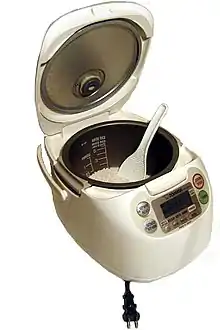
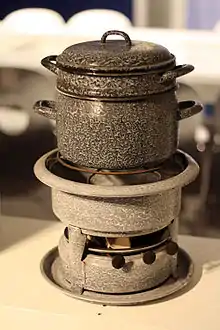
A rice cooker is a cooker that cooks rice.
Naming
The term rice cooker formerly applied to non-automated dedicated rice-cooking utensils, which have an ancient history (a ceramic rice steamer dated to 1250 BC is on display in the British Museum). It now applies mostly to automated cookers. Electric rice cookers were developed in Japan, where they are known as suihanki (炊飯器, literally, boil-rice-utencil).
Principle of operation
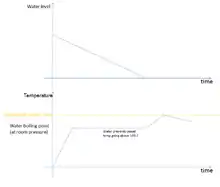
A basic rice cooker has a main body (pot), an inner cooking container which holds the rice, an electric heating element, and a thermostat.
The bowl is filled with rice and water and heated at full power; the water reaches and stays at boiling point (100 °C, 212 °F).[1] When the water has all been absorbed, the temperature can rise above boiling point, which trips the thermostat. Some cookers switch to low-power "warming" mode, keeping the rice at a safe temperature of approximately 65 °C (150 °F); simpler models switch off; the rice has entered the resting phase.
More advanced cookers may use fuzzy logic for more detailed temperature control, induction rather than resistive heating, a steaming tray for other foods, and even the ability to rinse the rice.[1]
Time
Depending on quantity, it takes about 20 minutes to 1 hour for most electric rice cookers to complete cooking. Some advanced models can back-calculate the cooking start time from given finish time. The time required for cooking rice depends on the amount of rice, the power of the heating elements, and atmospheric pressure, thus it is not constant. Pressure-cooker models are not influenced by atmospheric pressure. The special features distinguish high-end models from lower-cost, simpler models.
Purpose
Cooking rice has traditionally required constant attention to ensure the rice was cooked properly, and not burnt. Electric rice cookers automate the process by mechanically or electronically controlling heat and timing, thus freeing up a heating element on the cooking range that had to be otherwise occupied for rice cooking. Although the rice cooker does not necessarily speed up the cooking process, with an electric rice cooker the cook's involvement in cooking rice is reduced to simply measuring the rice, preparing the rice properly and using the correct amount of water. Once the rice cooker is set to cook, the rice will be cooked with no further attention.
Some types of rice dishes require special ways of preparation and are not suited to the mode of cooking used by electric/gas rice cookers. These recipes include, e.g., risotto, pilaf, paella, and stuffed peppers (capsicums). They must be cooked by hand. A rice cooker can be used to cook many grain foods usually boiled or steamed, such as pot barley, bulgur wheat, and dried split pulses.
Provided the ingredients have similar cooking times, a rice cooker can cook mixtures such as khichdi. Some rice cookers can be used as automated couscoussiers, cooking couscous and a stew simultaneously. However, many rice dishes, including risotto, paella, and rice-stuffed vegetables, cannot be prepared in a rice cooker.
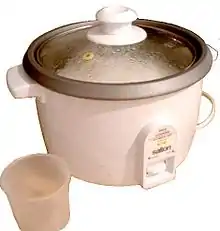
Method
The rice is measured and added to the inner bowl or washed in a separate bowl in order to remove loosened starch and residual bran. It is not recommended to wash rice in the inner bowl itself so as to preserve the non-stick surface. Strainers are often used in the washing and draining process. For better texture and taste, some types of rice, e.g., Japanese rice or Calrose rice which is suited for absorption method, require pre-cooking water absorption. The water absorption step typically involves letting the rice stand for at least 5 min after draining water from the washing step and soaking the rice in the measured water for at least 15 min (or some claim it to be 1 hour) before cooking. The water draining step is colloquially believed to make the water measurement more accurate, if the water is measured and added after the initial water absorption that takes place in the washing step. Some people prefer to achieve the water absorption by simply leaving the rice soaking in the rice cooker overnight before starting cooking in the morning. Some other types of rice, e.g., long-grain rice or scented rice such as jasmine rice, do not require washing or the water absorption step. The water for cooking is added to the inner bowl by using measuring cups or simply filling up to the appropriate graduated mark in the inner bowl. Although cold water is normally added, boiling water is used for cooking sushi rice.
Different kinds of rice require different amounts of water. Usually, there are graduated marks for the right amount of water only for white rice, but sometimes there are separate scales for brown rice (as more water is required) or for cooking other food in the appliance.
Once the lid is closed and the cooking cycle has been activated, the rice cooker does the rest. Most models give a countdown in minutes to the "ready time," or beep when done. After cooking cycle is completed, it is recommended that the rice is to "rest" for 5 minutes for post-absorption and then to be stirred to prevent the grains from clinging to each other too hard. Some rice, e.g., long-grain or scented rice, do not seem to require this post-absorption step.
Some higher-end models automatically time the soaking (pre-cooking water absorption) and the resting periods, therefore, there is no need to manually manage the water absorption or time these steps.
Appliance type
Automatic rice cookers may be either gas or electrical appliances. Most dedicated home rice cookers are of the electric type. In commercial or industrial use, there are many varieties, such as large gas or electric rice cookers, a large-scale rice cooker that is called a "rice boiler", and fully automatic versions which handle the whole process of rice cooking from washing rice to the end of the cooking cycle.
Many modern cookers have a heat-insulating casing and a warming mechanism. When the rice is determined to be fully cooked, the unit will automatically switch to the "keep warm" cycle, thus preventing the rice from being overcooked and keeping the rice warm until it is ready to be served. The degree of insulation provided by the casing can also be used to keep cold solids cold.
Electric rice cookers
The cooker works on a fluctuating magnetic field around the coil. It creates an electric current that flows through the vessel. Good induction saves time and heats up more quickly than a gas burner. Cleaning is hassle-free.[2]
Features and specifications

For modern home rice cookers, the smallest single-person model cooks 1 rice cup (180 ml), whereas large models can cook 10 cups. Commercial models can cook 20 or more cups. As a possible source of confusion, model specifications and names may list either cooked or uncooked capacity. Rice roughly doubles in size during cooking; therefore, a 10 cup (uncooked) rice cooker can produce up to 20 cups of cooked rice. The prices vary greatly, depending on the capacity, features, materials used, and the country of origin.
The majority of modern electric rice cookers are equipped with a stay-warm or keep-warm feature, which keeps the rice at an optimal temperature for serving without over-cooking it. Some gas cookers also have electric stay-warm mechanism. However, the usefulness of this feature degrades over time, a microwave may be more energy efficient or better suited to reheat rice that will sit longer than four hours.
Some rice cookers use induction heating, with one or more induction heaters directly warming the pot. This can improve energy efficiency.
Most modern rice cookers use aluminium for the inner cooking bowl. There are some models that use stainless steel instead of aluminium. Various other materials, such as copper, pure carbon, ceramic, and diamond powder coating, may be used for higher heat conductivity or better taste.
The pressure-cooking models can raise the water's boiling point higher, e.g., from 100 °C at 1.0 atm up to about 110 °C at 1.4 atm, which speeds cooking. The pressure-cooking models can also be used in high altitude areas, where the boiling temperature is below 100 Celsius. Pressure cookers are also suitable for cooking brown rice (which contains oils and bran fiber that cook differently from pure white rice starch). Some pressure rice cookers have a varying pressure control mechanism (named the "dual-pressure" method) that creates repeated pressure/release cycles during the cooking.
There also exist mechanisms to collect and return the boiled over liquid to the inner rice bowl.
Many cookers now have microprocessor-controlled cooking cycles, which are often used to adjust for rice and cooking type.
Rice types and rice cookers
Rice cookers are typically used for the preparation of plain or lightly seasoned rice. Each rice cooker model may be optimized to cook a certain type of rice best.
The typical methods of cooking long-grain rice are boil-and-strain and steaming. The absorption method used in Japanese rice cookers will produce slightly different texture and taste, usually stickier rice.
Brown rice generally needs longer cooking times than white rice, unless it is broken, or flourblasted (which perforates the bran).[3]
Different varieties of rice need different cooking times, depending on their grain size, grain shape, and grain composition. There are three main types of Asian rice: Oryza sativa subsp. indica, i.e., Indian rice (long grain rice, e.g., basmati rice and Thai jasmine rice), O. sativa subsp. javanica, i.e., Java rice (large grain rice) and O. sativa subsp. japonica, i.e., Japanese rice (medium grain rice, e.g., Calrose rice, short grain rice, e.g., most Japanese rice and risotto rice).
African rice, Oryza glaberrima, is an entirely separate species, but can be cooked in the same way. Zizania is not in the same genus, but is often called a rice (or "water oats"); it too can be cooked in a rice cooker.
Extended uses
Some rice cookers have settings for congee, a type of rice porridge called okayu in Japanese, juk in Korea, zhou in Chinese, Lugaw in the Philippines and Cháo in Vietnamese.
Many models feature an ability to cook sticky rice or porridge as an added value. Most can be used as steamers. Some can be used as slow cookers. Some other models can bake bread or in some cases have an added function to maintain temperatures suitable for fermentation of bread dough or yogurt. Multi-purpose devices with rice cooking capability are not necessarily called "rice cookers", but typically "multi-cookers".[4]
More elaborate recipes are possible using a rice cooker, and there are cookbooks devoted entirely to dishes prepared using a rice cooker. It is possible to cook soups, stews or sponge cakes in electric rice cookers. By simply adding ingredients and setting it to "warm", a rice cooker cooks the contents at about 65 °C (150 °F). In a few hours, the stew is fully cooked and ready to eat.
Some rice cookers can accommodate a steaming basket for vegetables and other foods above the rice.
A rice cooker, or slow cooker, can be used in conjunction with a temperature probe and an external thermostat to cook food at a stable low temperature ("sous-vide").[5]
Gas rice cookers

Gas rice cookers have a significantly larger capacity than home rice cookers (5 to 10 liters) and are more commonly used for commercial purposes. They must be connected directly to a fuel source (either a natural gas line or a portable propane source) and do not require an electrical power supply.
When cooking in a commercial setting, where quality, quantity, and speed are important factors, gas powered rice cookers offer several benefits. The gas powered flame source heats the cooking pot much more quickly than electrical power sources. Cooking at higher temperatures allows the rice to absorb water faster and cook more quickly, yielding a sweeter and more firm final product. Due to the amount of rice being cooked at one time, electrical powered cookers are not able to heat the cooking pot fast enough. This usually results in uneven cooking of the overall batch of rice-often leading to mushy or burnt rice on the bottom of the pot and sometimes under-cooked rice at the middle and top of the cooking pot. Finally, being able to heat the cooking pot to a higher temperature relatively quickly allows the rice to cook faster and steam properly, resulting in a better quality batch of rice.
Most, if not all, gas rice cookers use a heat based automatic shut-off system. The basic principle of these systems is such that gas flow into the burner is halted once a specific temperature is reached, resulting in the burner flame to go out.
A relatively new concept is the commercial gas pressure cooker. These cookers use pressure cooking to produce a uniformly cooked batch of rice. Cooking rice in a pressure cooker allows the rice to cook under more optimal conditions.
Ideal cooking for rice employs a method of a fast heating source along with a uniform delivery of that heat. A gas powered pressure cooking system is able to use a flame heat source to heat the cooking vessel quickly and the pressure cooker is able to uniformly heat the internal cooking environment to higher than the boiling point of water.
Induction Heating Rice Cooker These modern and high tech rice cookers are the best rice cooker in the market out there. They may be considered state of the art in rice-making. Induction heating rice cookers not only have multiple rice cooking settings but they can also perform many other cooking tasks. This category is highest price rice cookers so far.
How does induction rice cooker work? An induction rice cooker produces a magnetic field that by contacting the cooking pot heats it faster than normal rice cookers. The only drawback of these rice cookers is they are bit expensive and consume more energy. Here is the list of its main characteristics: – Removable lid, non-stick inner pot, easy to clean – Accessories are easy to wash and dishwasher friendly – Most induction cookers have settings for jasmine rice, brown rice, white rice, sushi rice and more – Digital and multi-functional control pad – Keep warm mode and delay timer
Standard Rice Cooker
Electric rice cookers can be found since decades past annually 1955. That is when initial rice cookers were dispersed available and there were millions sold since then. Rice cookers available today aren't much different from people of old variants that entered the industry back then.
A thermal detector in the rice cooker discovers if all the water was evaporated then it automatically shuts off the cooking procedure. Standard rice cookers have been easy apparatus that does a fantastic job of creating rice.
Following are some primary characteristics of a typical rice cooker:
- Easy & easy to function, add water, rice and press on the button
- Non-stick bud is easy to clean - Available in many different sizes - Rice cookers have removable power cord
History
In 1937 the Imperial Japanese Army sanctioned a Type 97 automobile-kitchen equipped with a primitive rice cooker. The rice cooker was a rectangular wooden box with two electrodes attached to opposite ends. To cook the rice, the box was filled with washed rice and water, and then a current was applied. This caused the water to boil. When the rice was cooked, the reduction of the water quantity caused an increase in resistance which reduced the power to a stay-warm state. This method, however, was not suitable for different water qualities or degrees of rice washing and as such varied the amount of heat produced and the end results. It also presented a high risk of electrocution, thus it was not suitable for home cooking.
In 1945, the Japanese Mitsubishi Electric Corporation was the first company to produce an electric commercial rice cooker. The Mitsubishi product was an aluminium pot with a heating coil inside. It had no automatic turn-off facility, and it required constant monitoring during cooking.
In the early development phase, electric home rice cookers used the simple concept of heating the rice to cook and turning off the heater when the temperature rose to a certain point. This method, however, is influenced too greatly by variation of room temperature and often produced under-cooked rice. Many makers continued to experience failures in their ongoing trial-and-error approaches. At this stage, there was even a trial model which embedded the heating element in a traditional wooden rice container.
The first practical electric rice cooker was invented by Yoshitada Minami,[6][7] who had an association with Toshiba Electric Corporation. It became possible to cook rice practically by employing the triple-chamber rice cooker (that provided heat insulation by air layers).
In December 1956, the Toshiba Corporation placed the first commercially successful automated electric rice cookers on the market.[8] It used a double-chamber indirect rice cooking method. Rice was placed into the rice pot, and water into a surrounding container. When the water in the outer pot boiled off, the temperature of the pot rose rapidly. A bimetallic thermostat then activated, and automatically turned off the cooker to prevent burning of the cooked rice. Soon, Toshiba was producing 200,000 rice cookers per month for the Japanese market. Four years later, rice cookers could be found in half of Japanese homes.
The double-chamber indirect cooking model took more time to complete cooking and also consumed more electricity. This model was gradually phased out in the 1960s, but there are some companies, such as Tatung, that still manufacture them. Today, electric rice cookers utilize an insulated outer container and an inner removable bowl, often coated with a non-stick surface, and stamped with water-level graduations marked in cups of rice used. The rice cup measure is normally based on the traditional Japanese measurement system 1 gō (合), which has its origin in China (Chinese: 合; pinyin: gě). One gō (合) is 180 ml, or approximately 25% smaller than the American measuring cup of 8 (US) fluid ounces/240 ml, and is regarded as producing enough cooked rice for a single meal for one person.
Initial models did not have a keep-warm feature and the cooked rice cooled down too quickly, thus it was often necessary to move the cooked rice to heat-insulated serving containers. In 1965, Zojirushi Thermos company started selling electric rice cookers with a stay-warm function, using a semi-conductor heat regulator. The product sold 2,000,000 units per year. Other makers soon followed suit. The stay-warm function can typically keep rice warm for up to 24 hours at a temperature high enough to suppress growth of Bacillus cereus, a cause of food poisoning. Allegedly this is not always the case, though some manufacturers state 12 hours as a max.[9]
Another notable improvement was the use of electric timers.
In simple models, a mechanical thermostat is used to turn off the cooker when the rice is ready. Since the 1980s, higher-end electric rice cookers have used microprocessors to control the cooking process, often incorporating a memory and electronic timer that can be used to set the desired "ready time". Since the 1990s, many models allow users to select desired cooking results for rice (e.g., soft, medium, firm, etc.), different types of rice, or ingredients other than rice. Some models can be used as steamers.
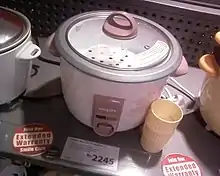
In the late 1980s, some higher-end electric rice cookers started using induction heating. This type aims to produce tastier cooked rice by controlling the heating process more precisely. Some other pressure-cooking models use 1.2 atm to 1.7 atm (not over 1.4 atm for home appliances) to raise the cooking temperature over 100 °C. Expensive models often provide a steam-heating function.
In the 1990s, China started-mass-producing economical electrical rice cookers with limited functions and exporting them to many countries. Japanese makers have been attempting to compete by seeking a niche in models with added values by increasing the number of features of their products.
In the 2000s, more deluxe models appeared on the market and attracted much attention. These models are characterized by non-metallic materials for inner cooking bowls to employ thermal far-infrared radiation in order to improve the taste of cooked rice. In 2006 Japanese Mitsubishi Electric corporation produced an expensive cooker which used an inner cooking bowl called honsumigama (本炭釜) made of hand-carved pure carbon, with a better heat-generating profile with induction cooking. Despite the high price (¥115,500, about US$1,400 at the time), it sold 10,000 units within six months after it was introduced. It was a huge success and it set the trend of extremely high-end models in the market. There is also a product which uses pottery, e.g., Arita-yaki, for the inner cooking bowl. There have been pottery-based electric cooking appliances in China since the 1980s, and in recent years rice cookers have been also produced. Some other materials used for luxurious rice bowls are pure copper, ceramic-iron layers, and diamond coating. These rice cooker makers research what the best cooked rice means (in taste and texture) and attempt to realize "the best cooked rice" in electric rice cookers by using various inventions. Most regard rice cooked either in a traditional rice cooker used in hearth or in a gas pressure cooker as references, and attempt to achieve or exceed the same.
Restaurants that serve much rice, particularly those specializing in Asian cuisine, often use industrial-sized rice cookers (often they are gas pressure cookers, but there are electric models) that quickly and cheaply produce large quantities of cooked rice. A rice cooker is a standard appliance in kitchens in many Asian countries and households.
Production
There were approximately 85 million rice cookers made in 2005. Most of the rice cookers were made in China, Taiwan, South Korea and Japan, with 70% of the production in China. Most of Chinese production was from Zhanjiang City and Lianjiang City in Guangdong Province.
Japanese rice cookers used overseas
Since the 1980s, electric rice cookers were manufactured in China, Taiwan and Korea, who focused on simple feature models.
See also
References
- "Rice Cooker Basics". How Stuff Works. Retrieved 10 February 2019.
- https://www.reviews.in/best-induction-cooktop.html#Extra-heading1
- ars.usda.gov Agriculture Research, May 2002
- Kate Hilpern (21 September 2018). "9 best multi-cookers". The Independent. Retrieved 10 February 2019.
- Gabrielle Taylor (5 September 2013). "How to Cook Food Perfectly at Home with a Super Cheap DIY Sous Vide Machine". Food Hacks. Retrieved 10 February 2019.
- プロジェクトX 挑戦者たち. nifty.com (in Japanese).
- 断腸亭日常日記 2001年、その4. biglobe.ne.jp (in Japanese).
- "Toshiba Firsts Of Their Kind". Toshiba Corp. Museum. Archived from the original on 2011-10-05. Retrieved 2010-03-14.
- https://www.quora.com/How-many-days-can-you-keep-rice-in-a-rice-cooker-until-it-goes-bad/answer/Lynetta-Carnes
Further reading
| Wikimedia Commons has media related to Rice cooker. |
| Wikibooks Cookbook has a recipe/module on |
- Nakano, Yoshiko (2009), Where There Are Asians, There Are Rice Cookers: How 'National' Went Global via Hong Kong, Hong Kong University Press, ISBN 978-988-8028-08-5